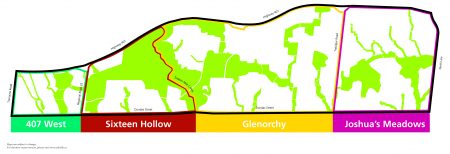LOCATION: East Side of Sixth Line and South of Highway 407
WATERSHED: Sixteen Mile Creek (Morrison Wedgewood Subwatershed)
TIMELINE: 2017–2019
In 2018, Conservation Halton carried out an ecological restoration project contributing to the North Oakville Natural Heritage System in what will be locally called Loyalist Woods. Once established, this restoration project will be maintained by the Town of Oakville as part of their parks and open space system. The restoration objectives for the project aim to create new wetlands, improve wildlife habitat, restore the woodland edge (the meeting point of urban development and natural woodland), and increase the biological diversity on site. Overall, these objectives will contribute to improving the health of the wetland as well as the North Oakville Natural Heritage System.
The restoration project site is located directly beside an existing woodland that contains small wetlands. This woodland and wetland area provides habitat for wildlife and contributes to improved water quality.
Wetlands have many benefits to the natural environment and to people. Wetlands are like a big sponge on the landscape. They filter and hold water, prevent flooding, and contribute to groundwater recharge. Many plants and animals call wetlands home including species at risk such as the federally listed Western Chorus Frog.
Less than 30% of our original wetlands remain in southern Ontario. In the Niagara and Greater Toronto Area, that number drops to 10%. This restoration project is an important step to reverse this loss.
Healthy woodlands mean healthy communities; physical and mental health benefits of woodlands are increasingly being documented and understood by scientific researchers.
Wetlands & Water
Three small wetlands were created in the North OakvilleMilton East Wetland Complex. The wetlands provide breeding habitat for a wide diversity of wildlife, including the Western Chorus Frog. Each of the newly created wetlands behave a little differently: providing different conditions to suit different species.
Shrubs and plant debris were included for native species to lay eggs, and hide from predators. The native trees and shrubs that were planted in the area, surrounding the wetland pools, will host beneficial insects, which in turn will feed amphibians, birds, and turtles. The tree and shrub plantings will eventually mature into a native deciduous forest ecosystem. Large woody debris (i.e. tree trunks) were scattered about in open areas to provide habitat for a range of organisms including plants, mosses, lichens, small animals, and insects. Decaying wood is an organic material that has the following benefits for the soil and plants:
- stores nutrients
- improves drainage
- holds moisture
- balances the pH levels
- home for insects beneficial environment (fungus, bacteria, and other microbes)
Soil & Carbon
To improve soil conditions and aid plant establishment, the soil surrounding tree and shrub plantings were treated with a powdered mix of mycorrhizae fungi. The added fungi forms a mutually beneficial relationship with the plant roots. The fungi provide nutrients and water to the establishing plants and in return, the plants provide sugars to the fungi.
To simulate the conditions of a natural wetland, organic material was added to the soil in the form of biochar and woody debris. Biochar is a charcoal and ash product made from burning plant material under low air and high temperature conditions. Organic material helps the wetlands to harbour water-purifying microbes. This biochar is very stable and locks carbon in the soil without decomposing.
Acorn Genetics
This project included the planting of two species of naturally occurring hybrid oaks including:
- Bur x Swamp White Hybrid Oak (Quercus x schuettei)
- White x Bur Hybrid Oak (Quercus x bebbiana)
These, and other hybrid oak species occur naturally in Oakville. Hybrid oaks tend to produce acorns earlier than pure oak species, yielding acorns after 10 years versus 20.
Once established, this project will provide a healthier watershed for wildlife and the residents of Halton
A natural heritage system looks to create a network of various habitat features and functions including woodlots, creeks, meadows, and thickets rather than isolated greenspaces separated by homes, businesses and roads. The systems approach is considered the best opportunity to preserve and protect living natural systems. North Oakville is one of the largest undeveloped parcels of land within Halton Region at 3,100 hectares. The area is expected to accommodate 50,000 people and around 25,000 jobs. A total of 900 hectares will be preserved within the North Oakville Natural Heritage System, which is nearly one third of the land in North Oakville. This project will be located in the centre of a new business park, which will include a municipal trail system.
This restoration initiative significantly improves these areas to ensure they are more resilient to the impact of climate change, and provide benefits to the local community. The restoration of the North Oakville Natural Heritage System will improve the Provincially Significant North Oakville-Milton East Wetland Complex and improve the health of the entire watershed.
New Communities of Oakville

Supporting Policies and Plans
This project supports and implements initiatives which contribute to the following:
- Conservation Halton Strategic Plan
- North Oakville Natural Heritage System
- Federal Species at Risk Recovery Strategy for the Western Chorus Frog


